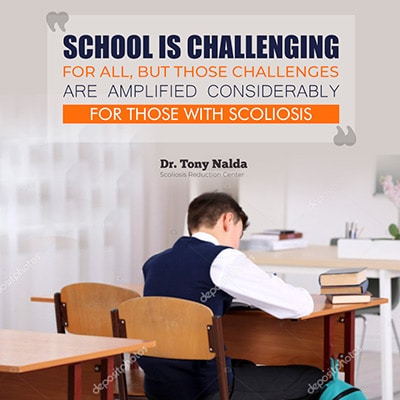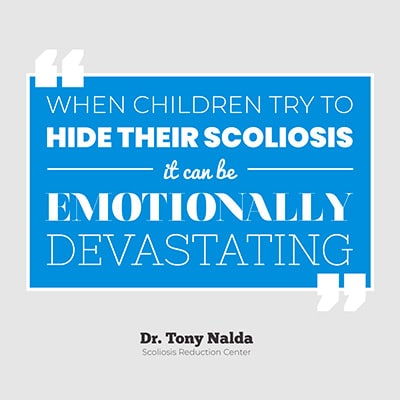It’s that time of year again. Summer has come to a close and kids are back in school. Where does the time go?

Scoliosis and school are closely related. Many of us associate scoliosis with visits to the school nurse during adolescence to perform the classic Adam’s forward bend test. For children with adolescent idiopathic scoliosis, getting through the school year — and the school day, for that matter — can be a challenge that shapes their development.
School is challenging for all adolescents, but those challenges are amplified considerably for those with scoliosis. We all know that school isn’t just a place to learn; it’s also a social setting and the place where our first meaningful relationships with non family members develop and grow. For children with scoliosis, their condition affects every single moment and interaction at school.
So, how can adolescents with scoliosis and their parents make the school experience a better one?
I believe there are three main areas to consider. Let’s get into them!
#1 — Carrying the Weight
Backpacks. They are the most common accessory an adolescent will carry with them during the school year. For a child with scoliosis — or one who may be at risk of developing the condition or progressing an existing curve — backpacks take on extra significance.
I don’t know about you, but when I see the sheer amount of stuff that today’s teens are expected to carry with them, I am always surprised. Books, devices, athletic equipment and other items get lugged around all day long, and the spine bears the brunt of this physical exertion.
While there is no evidence that confirms heavy backpacks as a cause of scoliosis, carrying excess weight can certainly aggravate the condition and contribute to a worsening of spinal curvature.
Some Backpack Facts:
- 25% of adolescent students say they experienced back pain for at least 15 days of the school year
- 60% of students aged 12-17 carry backpacks that match or exceed 10% of their body weight
- More than 5,000 emergency room visits come from injuries related to backpacks
- Heavy backpacks contribute to poor posture, as well as neck and back strain. Muscle spasms, difficulty with breathing and other negative effects are also common

If you’re a parent of an adolescent with scoliosis, it’s important to make sure your child isn’t taking on a load that’s too heavy for them. Here’s what you can do:
- Make sure your child always uses both straps on the backpack
- Do not allow the weight of the backpack and its contents to exceed a maximum of 10% of the child’s bodyweight
- When shopping for a backpack, choose the smallest one possible; it should be able to carry all the necessary items, but it should not be so large that your child will be tempted to overload it
- Choose a backpack with wide, padded straps, which are superior to narrow, thin ones
- Ensure your child places the heaviest items closest to their back
- Make sure your child situates the backpack no lower than the small of the back
#2 — Handling the Social Side of School
A child’s experience of school is largely determined by the interactions they have with their peers. For adolescents with scoliosis, having a supportive friend group is vitally important.
Not everyone at school will be nice. Some kids will make fun of their peers with scoliosis. They will tease and remain ignorant of the condition. The important thing to convey to an adolescent with scoliosis is that those bullies are not their friends, anyway. They are going to say mean things. It’s tough to deal with, but it shouldn’t detract from the overall experience.

Key to experiencing school in a positive manner is developing a strong, core group of supportive friends. Adolescents with scoliosis should be open about their condition. They should feel comfortable sharing the realities of living with scoliosis. Being open, honest and forthcoming about the condition prevents self consciousness and anxiety. Otherwise, when children try to hide their scoliosis, it can be emotionally devastating.
A good group of friends will ask thoughtful questions based on genuine curiosity. They will listen intently when your child describes what it’s like to live with scoliosis and receive treatment. They will encourage your adolescent to do their exercises and participate in therapy. In short, they will provide the kind of support and assistance everyone deserves and that your child needs at this critically important age.
#3 — Getting Checked
You and I may remember scoliosis screenings in school, but today’s young people aren’t being screened for the condition as frequently as in the past.
These days, not all states require schools to screen for scoliosis. And those that do provide screenings offer just one.
If you are a parent of a child you suspect may have scoliosis, you cannot depend on school screenings to diagnose the condition. You need to be proactive and ensure that your child is screened once per year, ideally before school begins. Additionally, you cannot assume that the pediatrician or family doctor will automatically screen for scoliosis. It is something that you should request specifically.
As with many other conditions, early detection is critical for the treatment of scoliosis. Left untreated, it progresses steadily throughout adolescence and makes an already awkward time even more uncomfortable. But when it is detected early, treatment is much simpler and more effective.
We Are Experts on Adolescent Scoliosis
Understanding adolescent scoliosis can be difficult, and the condition is especially challenging for the young people who must live with it every day. But you don’t have to be left in the dark when it comes to understanding and treating the condition. Adolescents with scoliosis can live full lives that don’t relegate them to the sidelines, but they and their parents need to know how to approach the condition — particularly in terms of how they can handle the rigors of the school year.
If you are interested in learning more about what’s possible for adolescents with scoliosis and you want to make sure your child experiences school in the most positive, productive manner possible, I encourage you to reach out to us here at the Scoliosis Reduction Center® for more information. Just call 321-939-2328 or email [email protected] to learn more.





